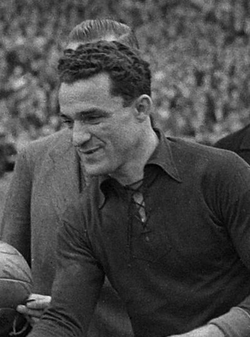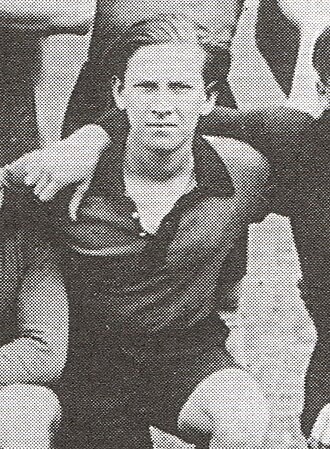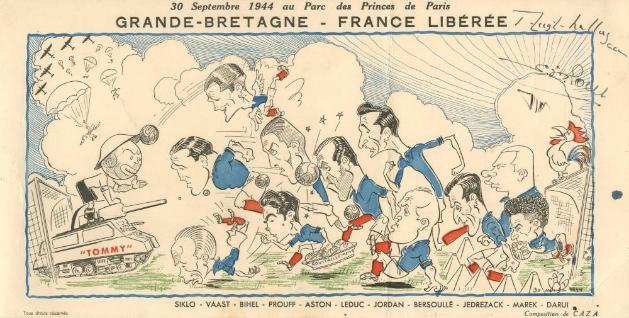Every Picture Tells a Story…
03/09/2025 - 9.52
Roger Slater
That’s what Rod Stewart would have us all believe anyway, however what follows may just go some way to proving his point. As you know, I love my football – especially the quirky bits which is probably why I follow Wealdstone) and I love things about World War One and Two, particularly if there’s a football link. This then, hits the spot.
While doing some research on Prisoners of War with a football link outside of Great Britain, I came across two names, Jean Prouff and Julien DaRui. Each had a similar though separate story, yet each story also came together…
At the invasion of France in August 1939, a large number of eligible Frenchmen were conscripted into the French Army and this included a number of sportsmen. At the time Julien Darui was the French International goalkeeper, despite having been born in Oberkom, Luxembourg, during World War One of Italian and Portuguese parents. The family emigrated to France when Julien was a young child and the fact he grew up there seems to have satisfied the criteria for qualification not only for the National Team but also for National Service!
Just before his twentieth birthday, he made a playing debut in goal for Olympique Charleville where he made 47 appearances over a couple of seasons before joining Olympique Lillois where he played until May 1940. At that point he joined the army (though whether this was conscription or choice is unclear). After basic training, he found himself in Northern France as part of the French Army, defending the British Expeditionary Force’s retreat to Dunkirk, at which point he was captured by the German Army and held as a Prisoner of War.
Not for long as it turned out, as while awaiting transfer from France to a camp likely in Germany or Poland, DaRui escaped, or more accurately, he seems to have walked out of the camp in Northern France and (obviously being fluent in the language helped!) he went home. One conscious decision he seems to have made when he got home however, was to not rejoin the football club he had played for at the outbreak of war, Olympique Lillois, instead joining another local side in Red Star Olympique where he remained for a couple of years. (In the meantime, France had signed an Armistice with Germany). From Red Star, he had a mandated move to Lille (of whom Lillois had been a forerunner) when the French FA stated that all players had to return to their pre-war clubs. He moved on again later in the war and most notably, in 1945, he joined CO-Roubaix-Tourcoing where he was to make 234 appearances. He later moved on again to Montpellier where he eventually retired from playing after circa 400 appearances for his clubs and twenty-five International Caps gained between 1938 and 1951, figures that no doubt would have been greater if war had not intervened. Hold that thought for a moment.

Julien DaRui, 1947. Source: CO-Roubaix-Tourcoing
Jean Prouff has a similar story. Born a few years later in 1919, in Peillac, south-west of Rennes, his family moved to the city when he was a youngster. It was there he first played football and he eventually joined Stade Rennais Universite Club at the age of 14. An all-rounder, he also played Rugby and excelled on the athletics track, but his passion for football was paramount and his performances in midfield were gaining notice. In 1935, with the side now known as Rennes, he was the young star performer in the Coupe de France des Espoirs as the young side ran out winners 5-1 against…Red Star, and Prouff scored twice.

Jean Prouff, 1935. Source: Stade Rennes FC
A year later and the family had moved to Nantes due to his father’s work and Jean signed for SC Fives, a forerunner of the modern-day Lille side which was formed when FC Fives and Olympique Lillois merged in 1944, but shortly after he signed his first contract, war broke out. Prouff like DaRui was drafted into service and he was assigned to a Military Engineers regiment in Northern France, who coincidentally happened to have one of the best military football teams.
Fighting the Germans in Eastern France in 1940, with his unit defending the Maginot Line, Prouff was captured and taken prisoner. As with DaRui, he was only a captive for a short time as he managed to escape. He then walked over 400 kilometres, seemingly unchallenged to Paris!
He did return home and to his former club in Nantes before re-joining Rennes in 1941. That was short lived as the French Football Federation (you’d think they’d have other things on their mind?) mandated that all players must return to the clubs they were signed to before the start of the war, as with DaRui, Prouff was ordered to return to his former club, SC Fives. He was only back there for a year before the Federation again made sweeping changes by assigning players across the new regional teams which had been created, with Prouff joining the Breton team in Rennes.
It seems that neither player was recalled by the French Army, and with the armistice signed with Germany, they could not be re-captured and held prisoner. Lucky escapes indeed as under the terms of the armistice, French Prisoners of War had to remain prisoners until a Peace Treaty was signed, and many found themselves in forced labour camps in Germany and Poland for the duration of the war in Europe. DaRui and Prouff were able to continue their careers throughout hostilities. Prouff also played international football for France, making 17 appearances between 1946 and 1949.
Following the liberation of France in 1944, the cities of Rennes and Nantes found themselves free and with the football teams starting to reshape themselves into more recognisable teams and leagues, DaRui and Prouff found themselves called up to a National representative team.
The match was to be a celebration of Liberation, a Great Britain side (drawn from the British Army) set to play an unofficial International on the 30th September 1944, against the (equally unofficial) French National XI. DaRui seems to have made his way to the Parc du Princes, Paris, for the match with no concerns, but Prouff was unable to secure transport, so he decided to cycle the 200 miles from Rennes to Paris, succeeding in reaching the capital within two days and little more than a couple of hours before the start of the game. His fitness was not to be questioned though as he then went onto the pitch with his teammates to warm up for the match despite the journey, though teammate Darui is reported to have said “…you have the nerve to warm up before the game when you have just cycled 300km?”
That is the story, and this is the picture:

Cartoon From The Match. Source: Author's Collection
A wonderful cartoon drawing of the French Team from the match that came up in a search online, the original image having been sold in an auction. I wonder still if the depiction of the British Tommies in their tank under a sky full of the D-Day Invasion paratroopers was noticed by the French, in particular the two players in the French XI that had, all be it for a short time, been Prisoners of War?
You may also notice two signatures on the original image in the top right? They are (below) Sir Stanley Rous, a name you will surely know from ‘football circles’ as the Secretary of the Football Association for almost 30 years and subsequently the 6th President of FIFA. Above his signature, is that of Air Chief Marshall Trafford Leigh-Mallory, Commander of No12 Fighter Group during The Battle of Britain. He was killed when his plane crashed just six weeks after the match on 14th November, 1944. Perhaps there’s another story there…
Note:
This article was first published in the football fanzine - Where's The Bar? If you would like to find out more about the fanzine and be able to order back issues as well as the current issue, go to: https://www.wheresthebar.co.uk/
Biography
Roger Slater was born in Harrow in the late 1950s and has moved around a bit and retired to Devon with wife of 24 years, Helen. He originally trained as an Electrical Engineer but worked for almost 40 years in Building Services Technologies, primarily HVAC control systems and Electronic Security. Roger retired in 2018 having run his own Engineering Consultancy for almost 15 years.
For relaxation and hobbies, he writes, mainly about his football club, Wealdstone FC and has published eight books including a club history since 2002. He does not class himself as a historian, just an enthusiastic amateur.
He also writes for a fanzine/magazine called Where’s The Bar that has just relaunched.
Otherwise, hobbies are upcycling and building ‘strange’ lighting out of people’s rubbish and occasionally painting, though he also buys and sells at auctions and on the internet (mainly football related or antiques).
In respect of other sports, he will watch most but follows the Toronto Blue Jays avidly in baseball, as a result of working on and off in Canada in the early nineties.
Roger also reads and collects books on World War One, in particular personal biographies and war diaries as opposed to battle histories…
All of that could change tomorrow or on any other day if something else takes his fancy as he will give most things a try if they appeal!!



/prod01/wlvacuk/media/departments/digital-content-and-communications/submitted-news-images/Smelting-knife.png)
/prod01/wlvacuk/media/departments/digital-content-and-communications/images-2024/250630-SciFest-1-group-photo-resized-800x450.png)
/prod01/wlvacuk/media/departments/digital-content-and-communications/submitted-news-images/Way-youth-zone-August.JPG)
/prod01/wlvacuk/media/departments/digital-content-and-communications/images-2024/Arthi-Arunasalam-teaser.jpg)
/prod01/wlvacuk/media/departments/digital-content-and-communications/submitted-news-images/Muslim-woman-playing-football.jpg)
/prod01/wlvacuk/media/departments/digital-content-and-communications/submitted-news-images/Business-School-800x450.jpg)
/prod01/wlvacuk/media/departments/digital-content-and-communications/submitted-news-images/University-of-the-Year.jpg)